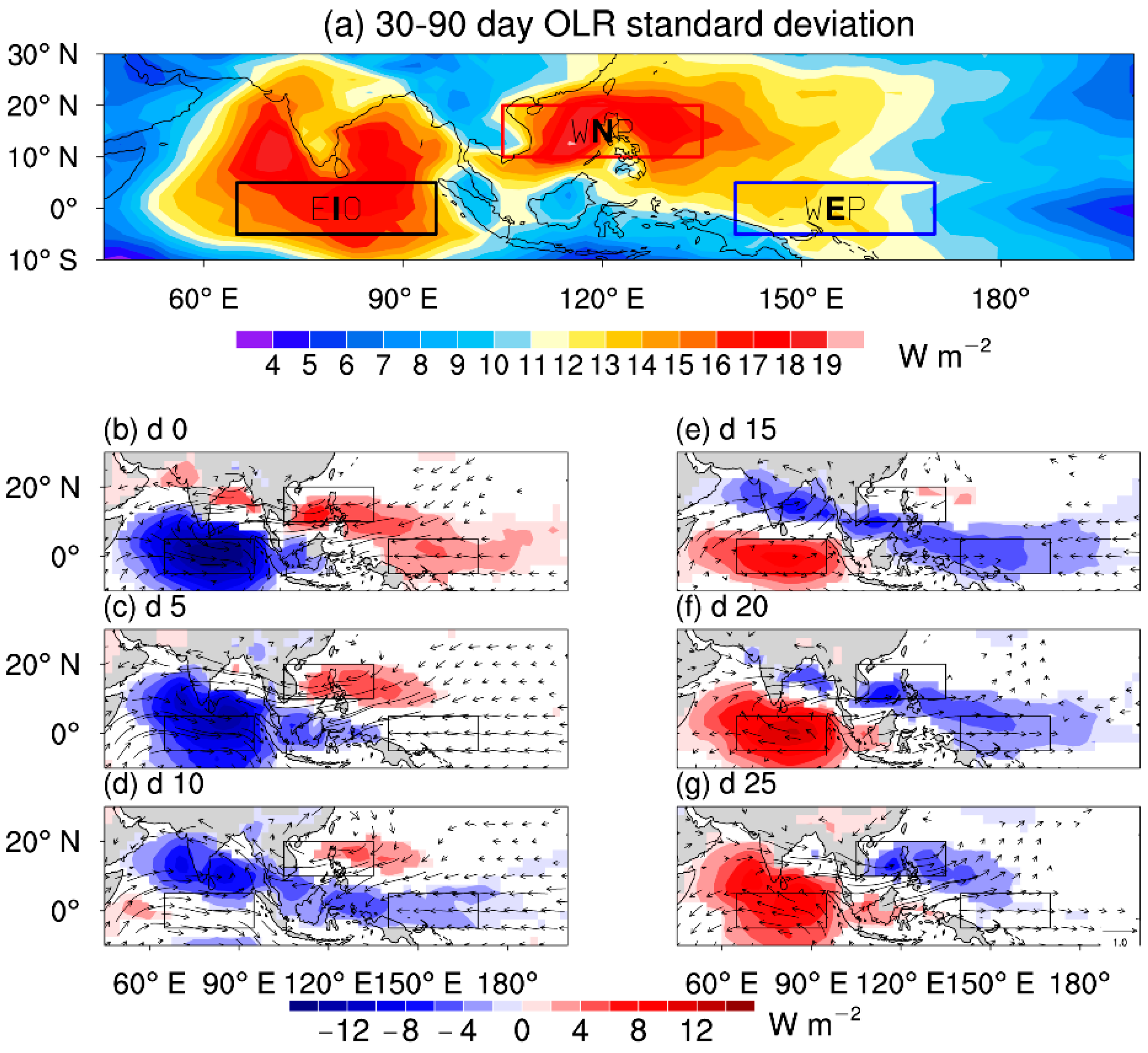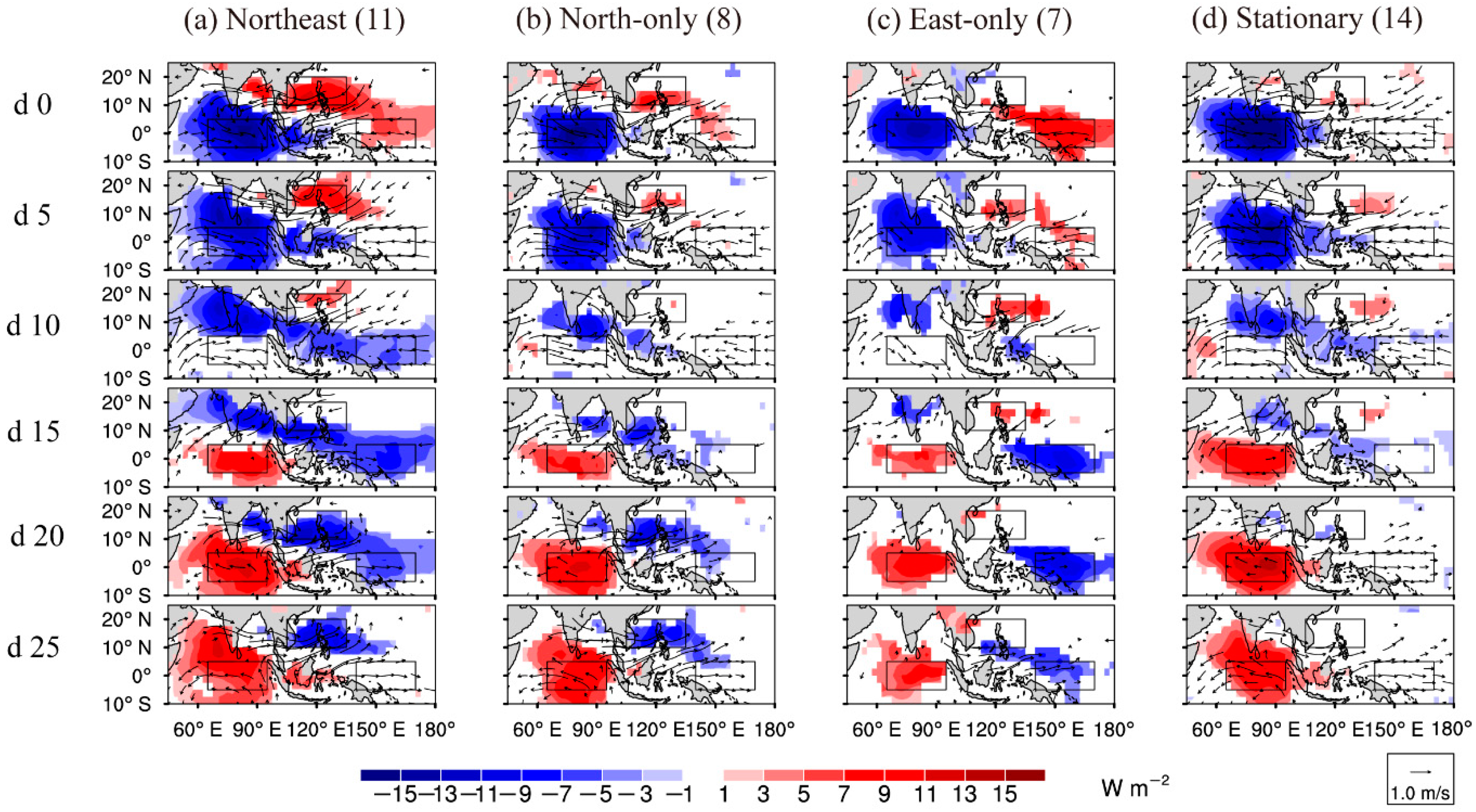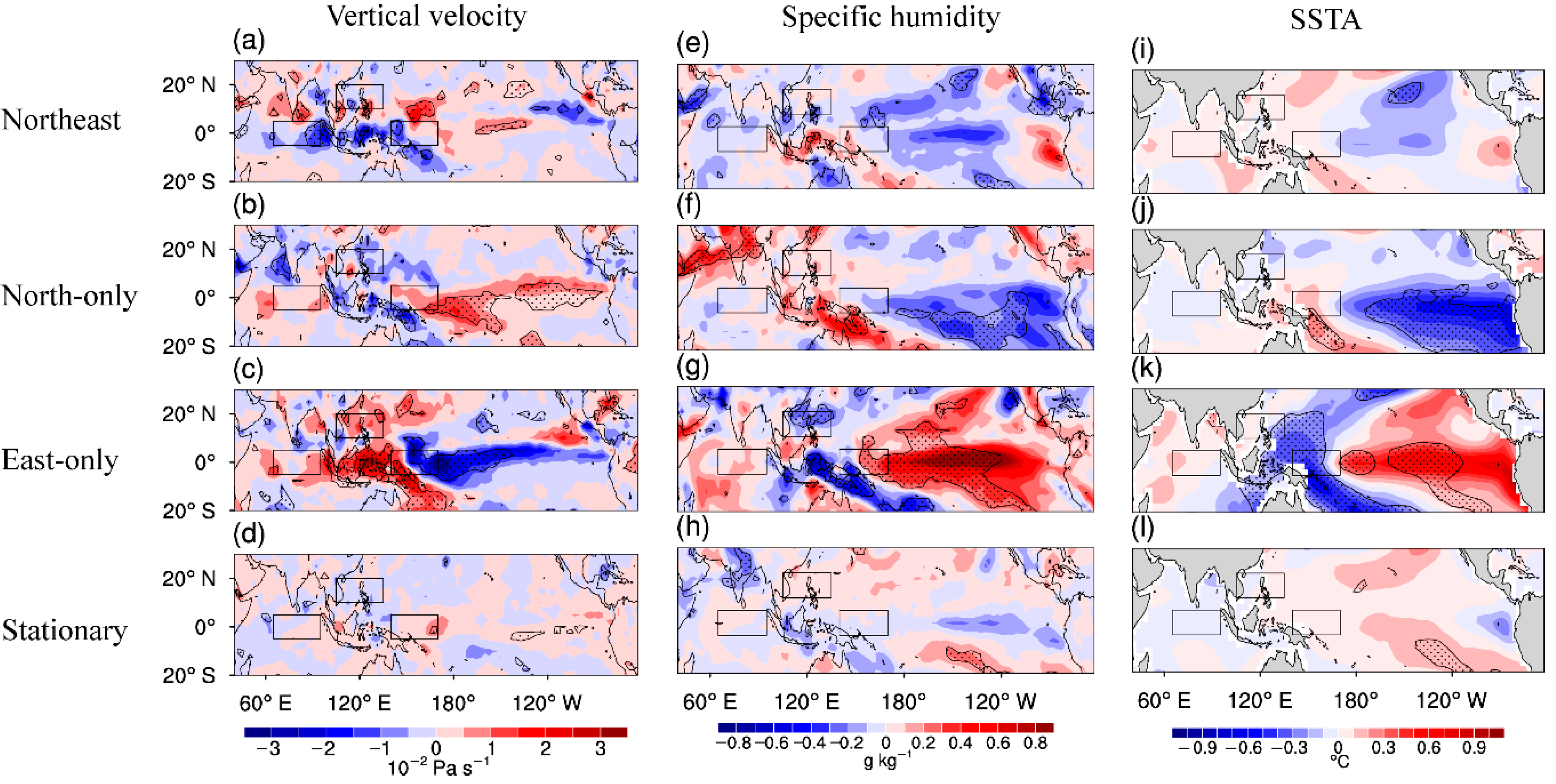Inter-Annual Variability of Boreal Summer Intra-Seasonal Oscillation Propagation from the Indian Ocean to the Western Pacific
Abstract
1. Introduction
2. Data and Methods
2.1. Data
2.2. Classification of BSISO Propagation from IO to WP
- A 5–30-day lagged window after the peak of EIO ISO is used to define whether the ISO signal over the WEP and WNP originates from the EIO. The 5–30-day lagged window is selected based on the evolution of regressed BSISO for all years over the WP from day 5 to day 30 (Figure 1).
- The ratio of WEP/WNP ISO strength during this 5–30 window to EIO strength is used to detect whether the ISO originating from the EIO may propagate to the WEP or WNP for a particular year. The ratio is used to eliminate the effect of BSISO strength at origin and isolate the role of mean state.
3. Four BSISO Propagation Modes
4. Different Background Characteristics of the Four Propagation Modes
5. Conclusions and Discussion
Author Contributions
Funding
Conflicts of Interest
References
- Madden, R.A. Seasonal variations of the 40–50 day oscillation in the tropics. J. Atmos. Sci. 1986, 43, 3138–3158. [Google Scholar] [CrossRef]
- Jones, C.; Carvalho, L.M.; Wayne Higgins, R.; Waliser, D.E.; Schemm, J.E. Climatology of tropical intraseasonal convective anomalies: 1979–2002. J. Clim. 2004, 17, 523–539. [Google Scholar] [CrossRef]
- Zhang, C.; Dong, M. Seasonality in the Madden–Julian oscillation. J. Clim. 2004, 17, 3169–3180. [Google Scholar] [CrossRef]
- Lau, K.-M.; Chan, P. Aspects of the 40–50 day oscillation during the northern summer as inferred from outgoing longwave radiation. Mon. Weather Rev. 1986, 114, 1354–1367. [Google Scholar] [CrossRef]
- Wang, B.; Webster, P.J.; Teng, H. Antecedents and self-induction of active-break south Asian monsoon unraveled by satellites. Geophys. Res. Lett. 2005, 32. [Google Scholar] [CrossRef]
- Yasunari, T. Cloudiness fluctuations associated with the northern hemisphere summer monsoon. J. Meteorol. Soc. Jpn. 1979, 57, 227–242. [Google Scholar] [CrossRef]
- Hsu, H.-H.; Weng, C.-H. Northwestward propagation of the intraseasonal oscillation in the western North Pacific during the boreal summer: Structure and mechanism. J. Clim. 2001, 14, 3834–3850. [Google Scholar] [CrossRef]
- Kemball-Cook, S.; Wang, B. Equatorial waves and air–sea interaction in the boreal summer intraseasonal oscillation. J. Clim. 2001, 14, 2923–2942. [Google Scholar] [CrossRef]
- Liu, F.; Li, T.; Wang, H.; Deng, L.; Zhang, Y. Modulation of boreal summer intraseasonal oscillations over the western north Pacific by ENSO. J. Clim. 2016, 29, 7189–7201. [Google Scholar] [CrossRef]
- Murakami, M. Analysis of the deep convective activity over the western Pacific and southeast Asia. J. Meteorol. Soc. Jpn. Ser. II 1983, 61, 60–76. [Google Scholar] [CrossRef]
- Wang, B.; Rui, H. Synoptic climatology of transient tropical intraseasonal convection anomalies: 1975–1985. Meteorol. Atmos. Phys. 1990, 44, 43–61. [Google Scholar] [CrossRef]
- Lawrence, D.M.; Webster, P.J. The boreal summer intraseasonal oscillation: Relationship between northward and eastward movement of convection. J. Atmos. Sci. 2002, 59, 1593–1606. [Google Scholar] [CrossRef]
- Pillai, P.A.; Sahai, A.K. Moisture dynamics of the northward and eastward propagating boreal summer intraseasonal oscillations: Possible role of tropical Indo-west Pacific SST and circulation. Clim. Dyn. 2015, 47, 1335–1350. [Google Scholar] [CrossRef]
- Hendon, H.H.; Zhang, C.; Glick, J.D. Interannual Variation of the Madden-Julian Oscillation during Austral Summer. J. Clim. 1999, 12, 2538–2550. [Google Scholar] [CrossRef]
- Salby, M.L.; Hendon, H.H. Intraseasonal behavior of clouds, temperature, and motion in the Tropics. J. Atmos. Sci. 1994, 51, 2207–2224. [Google Scholar] [CrossRef]
- Slingo, J.; Rowell, D.; Sperber, K.; Nortley, F. On the predictability of the interannual behaviour of the Madden-Julian Oscillation and its relationship with El Niño. Q. J. R. Meteorol. Soc. 1999, 125, 583–609. [Google Scholar] [CrossRef]
- Liu, F.; Wang, B. Role of horizontal advection of seasonal-mean moisture in the Madden-Julian oscillation: A theoretical model analysis. J. Clim. 2016, 29, 6277–6293. [Google Scholar] [CrossRef]
- Teng, H.Y.; Wang, B. Interannual variations of the boreal summer intraseasonal oscillation in the Asian-Pacific region. J. Clim. 2003, 16, 3572–3584. [Google Scholar] [CrossRef]
- Li, J.; Mao, J. Factors controlling the interannual variation of 30–60-day boreal summer intraseasonal oscillation over the Asian summer monsoon region. Clim. Dyn. 2018, 52, 1651–1672. [Google Scholar] [CrossRef]
- Deng, L.; Li, T. Relative roles of background moisture and vertical shear in regulating interannual variability of boreal summer intraseasonal oscillations. J. Clim. 2016, 29, 7009–7025. [Google Scholar] [CrossRef]
- Wu, R.; Cao, X. Relationship of boreal summer 10–20-day and 30–60-day intraseasonal oscillation intensity over the tropical western North Pacific to tropical Indo-Pacific SST. Clim. Dyn. 2016, 48, 3529–3546. [Google Scholar] [CrossRef]
- Kim, H.M.; Kang, I.S.; Wang, B.; Lee, J.Y. Interannual variations of the boreal summer intraseasonal variability predicted by ten atmosphere–ocean coupled models. Clim. Dyn. 2008, 30, 485–496. [Google Scholar] [CrossRef]
- Zhang, C.; Ling, J. Barrier effect of the Indo-Pacific maritime continent on the MJO: perspectives from tracking MJO precipitation. J. Clim. 2017, 30, 3439–3459. [Google Scholar] [CrossRef]
- Maloney, E.D.; Sobel, A.H. Surface fluxes and ocean coupling in the tropical intraseasonal oscillation. J. Clim. 2004, 17, 4368–4386. [Google Scholar] [CrossRef]
- Sobel, A.H.; Maloney, E.D.; Bellon, G.; Frierson, D.M. The role of surface heat fluxes in tropical intraseasonal oscillations. Nat. Geosci. 2008, 1, 653–657. [Google Scholar] [CrossRef]
- Adames, Á.F.; Kim, D. The MJO as a dispersive, convectively coupled moisture wave: Theory and observations. J. Atmos. Sci. 2016, 73, 913–941. [Google Scholar] [CrossRef]
- Raymond, D.J. A new model of the Madden-Julian oscillation. J. Atmos. Sci. 2001, 58, 2807–2819. [Google Scholar] [CrossRef]
- Hagos, S.M.; Zhang, C.; Feng, Z.; Burleyson, C.D.; De Mott, C.; Kerns, B.; Martini, M.N. The impact of the diurnal cycle on the propagation of Madden-Julian oscillation convection across the Maritime Continent. J. Adv. Modeling Earth Syst. 2016, 8, 1552–1564. [Google Scholar] [CrossRef]
- Burleyson, C.D.; Hagos, S.M.; Feng, Z.; Kerns, B.W.J.; Kim, D. Large-Scale Environmental Characteristics of MJOs that Strengthen and Weaken over the Maritime Continent. J. Clim. 2018, 31, 5731–5748. [Google Scholar] [CrossRef]
- Tan, H.; Ray, P.; Barrett, B.S.; Tewari, M.; Moncrieff, M.W. Role of topography on the MJO in the maritime continent: a numerical case study. Clim. Dynam. 2018. [Google Scholar] [CrossRef]
- Tseng, W.L.; Hsu, H.H.; Keenlyside, N.; Chang, C.; Tsuang, B.J.; Tu, C.Y.; Jiang, L.C. Effects of Surface Orography and Land-Sea Contrast on the Madden-Julian Oscillation in the Maritime Continent: A Numerical Study Using ECHAM5-SIT. J. Clim. 2017, 30, 9725–9741. [Google Scholar] [CrossRef]
- Fu, J.X.; Wang, W.; Ren, H.L.; Jia, X.; Shinoda, T. Three different downstream fates of the boreal-summer MJOs on their passages over the Maritime Continent. Clim. Dyn. 2017, 51, 1841–1862. [Google Scholar] [CrossRef]
- Kim, D.; Kug, J.S.; Sobel, A.H. Propagating versus nonpropagating Madden-Julian oscillation events. J. Clim. 2014, 27, 111–125. [Google Scholar] [CrossRef]
- Liebmann, B. Description of a complete (interpolated) outgoing longwave radiation dataset. Bull. Am. Meteorol. Soc. 1996, 77, 1275–1277. [Google Scholar]
- Lee, J.-Y.; Wang, B.; Wheeler, M.C.; Fu, X.; Waliser, D.E.; Kang, I.-S. Real-time multivariate indices for the boreal summer intraseasonal oscillation over the Asian summer monsoon region. Clim. Dyn. 2013, 40, 493–509. [Google Scholar] [CrossRef]
- Kobayashi, S.; Ota, Y.; Harada, Y.; Ebita, A.; Moriya, M.; Onoda, H.; Miyaoka, K. The JRA-55 Reanalysis: General specifications and basic characteristics. J. Meteorol. Soc. Jpn. 2015, 93, 5–48. [Google Scholar] [CrossRef]
- Huang, B.; Thorne, P.W.; Banzon, V.F.; Boyer, T.; Chepurin, G.; Lawrimore, J.H.; Zhang, H.M. Extended Reconstructed Sea Surface Temperature, Version 5 (ERSSTv5): Upgrades, Validations, and Intercomparisons. J. Clim. 2017, 30, 8179–8205. [Google Scholar] [CrossRef]
- Duchon, C.E. Lanczos filtering in one and two dimensions. J. Appl. Meteorol. 1979, 18, 1016–1022. [Google Scholar] [CrossRef]
- Maloney, E.D. The Moist Static Energy Budget of a Composite Tropical Intraseasonal Oscillation in a Climate Model. J. Clim. 2009, 22, 711–729. [Google Scholar] [CrossRef]
- Wang, L.; Li, T.; Maloney, E.; Wang, B. Fundamental causes of propagating and nonpropagating MJOs in MJOTF/GASS Models. J. Clim. 2017, 30, 3743–3769. [Google Scholar] [CrossRef]
- Annamalai, H.; Slingo, J.M. Active/break cycles: Diagnosis of the intraseasonal variability of the Asian Summer Monsoon. Clim. Dyn. 2001, 18, 85–102. [Google Scholar] [CrossRef]
- Li, T.; Wang, B. The influence of sea surface temperature on the tropical intraseasonal oscillation: A numerical study. Mon. Weather Rev. 1994, 122, 2349. [Google Scholar] [CrossRef]
- Wang, B.; Webster, P.; Kikuchi, K.; Yasunari, T.; Qi, Y.J. Boreal summer quasi-monthly oscillation in the global tropics. Clim. Dyn. 2006, 27, 661–675. [Google Scholar] [CrossRef]
- Deng, L.; Li, T.; Liu, J.; Peng, M. Factors controlling the interannual variations of MJO intensity. J. Meteorol. Res. 2016, 30, 328–340. [Google Scholar] [CrossRef]






| Names of Modes | Definition | Years |
|---|---|---|
| Northeast (11) | SWEP/SEIO > 0.42, SWNP/SEIO > 0.36 | 1997, 1992, 1998, 1999, 2000, 2001, 2002, 2007, 2008, 2009, 2014 |
| North-only (8) | SWEP/SEIO < 0.42, SWNP/SEIO > 0.36 | 1981, 1985, 1988, 1990, 2006, 2010, 2011, 2018 |
| East-only (7) | SWEP/SEIO > 0.42, SWNP/SEIO < 0.36 | 1980, 1983, 1986, 1987, 1993, 2004, 2015 |
| Stationary (14) | SWEP/SEIO < 0.42, SWNP/SEIO < 0.36 | 1982, 1984, 1989, 1991, 1994, 1995, 1996, 1997, 2003, 2005, 2012, 2013, 2016, 2017 |
© 2019 by the authors. Licensee MDPI, Basel, Switzerland. This article is an open access article distributed under the terms and conditions of the Creative Commons Attribution (CC BY) license (http://creativecommons.org/licenses/by/4.0/).
Share and Cite
Zhang, J.; Wang, H.; Liu, F. Inter-Annual Variability of Boreal Summer Intra-Seasonal Oscillation Propagation from the Indian Ocean to the Western Pacific. Atmosphere 2019, 10, 596. https://doi.org/10.3390/atmos10100596
Zhang J, Wang H, Liu F. Inter-Annual Variability of Boreal Summer Intra-Seasonal Oscillation Propagation from the Indian Ocean to the Western Pacific. Atmosphere. 2019; 10(10):596. https://doi.org/10.3390/atmos10100596
Chicago/Turabian StyleZhang, Jiayu, Hui Wang, and Fei Liu. 2019. "Inter-Annual Variability of Boreal Summer Intra-Seasonal Oscillation Propagation from the Indian Ocean to the Western Pacific" Atmosphere 10, no. 10: 596. https://doi.org/10.3390/atmos10100596
APA StyleZhang, J., Wang, H., & Liu, F. (2019). Inter-Annual Variability of Boreal Summer Intra-Seasonal Oscillation Propagation from the Indian Ocean to the Western Pacific. Atmosphere, 10(10), 596. https://doi.org/10.3390/atmos10100596





